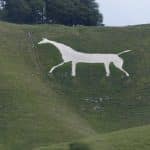Last Updated on 18/04/2023 by Alex Hamlyn
Table of Contents
Where is the Wilmington Long Barrow?
About the Wilmington Long Barrow
Discover the mysteries of the ancient world at the Wilmington Long Barrow in East Sussex, England! Built around 3500 BC, this Neolithic tomb is one of the largest and best-preserved examples of its kind in the country. Imagine the communal effort it took to construct this impressive structure, with its massive earthen mound covering a long, rectangular chamber and two side chambers.
Step back in time as you walk around the barrow and imagine the bustling activity of the prehistoric communities who used it as a communal burial tomb, marking their community identity and social organization. Can you feel the weight of the centuries as you imagine the remains of several hundred individuals interred within the chamber over the course of generations?
Don’t miss the chance to explore the ditch that once surrounded the barrow, a true feat of engineering by our prehistoric ancestors. The Wilmington Long Barrow has been the subject of several exciting archaeological investigations, uncovering new information about the lives of these ancient communities.
Today, it stands as a Scheduled Ancient Monument, protected for future generations to enjoy and learn from. So come and immerse yourself in the rich cultural heritage of England at the Wilmington Long Barrow!
The Wilmington Long Barrow consists of a long, rectangular chamber with two side chambers, which were covered by a massive earthen mound. The chamber was used for burials, and it is estimated that the remains of several hundred individuals were interred there over the course of several centuries. The barrow was originally surrounded by a ditch, which would have been a significant feat of engineering for the prehistoric people who built it.
The site was rediscovered in the 19th century and has since been the subject of several archaeological investigations, which have helped to shed light on the construction and use of the barrow and which have revealed important information about the social and cultural practices of prehistoric communities.
What makes the Wilmington Long Barrow special?
The Wilmington Long Barrow is unique in several ways compared to other barrows in the UK:
- Size: The Wilmington Long Barrow is one of the largest long barrows in Britain, measuring over 100 meters in length. This makes it an impressive structure, even by today’s standards, and it is a testament to the engineering abilities of the prehistoric people who built it.
- Side Chambers: The Wilmington Long Barrow has two side chambers, which are relatively uncommon in other long barrows in Britain. These side chambers would have been used for burials and provide valuable insights into the beliefs and cultural practices of the people who built the barrow.
- State of Preservation: The Wilmington Long Barrow is one of the best-preserved long barrows in Britain, and it provides a rare opportunity to see an ancient structure of this type in close to its original form.
- Location: The Wilmington Long Barrow is located in an area of East Sussex that is rich in prehistoric sites and monuments, including the Long Man of Wilmington, Marden Henge, and several other barrows and standing stones. This makes the area an important destination for those interested in the history and archaeology of Britain.
These factors make the Wilmington Long Barrow unique compared to other barrows in the UK, and it is considered to be an important part of Britain’s cultural heritage. Whether you are a historian, an archaeologist, or simply someone who loves to explore the outdoors, the Wilmington Long Barrow is well worth a visit for its size, preservation, and historical significance.
Who built the Wilmington Long Barrow?
The Wilmington Long Barrow was built by the prehistoric communities who lived in East Sussex, England during the Neolithic period. This period of British history lasted from around 4000 BC to 2500 BC and saw significant developments in agriculture, architecture, and social organization.
The exact identity of the people who built the Wilmington Long Barrow is not known, as they left no written records of their existence. However, archaeology has revealed that they were skilled builders who used locally sourced materials to construct impressive structures such as the barrow. It is likely that the barrow was built by a community of people who lived in the area and used it for communal burials over the course of several generations.
The Neolithic people of Britain were part of a wider cultural tradition that spanned Europe and saw the development of monumental architecture, including megalithic tombs, standing stones, and henge monuments. The Wilmington Long Barrow is an important example of this tradition and provides valuable insights into the beliefs, social organization, and technological abilities of our Neolithic ancestors.
How was the Wilmington Long Barrow built?
The Wilmington Long Barrow was built by the prehistoric communities who lived in East Sussex, England during the Neolithic period. The exact methods used to construct the barrow are not known, as there are no written records from the time, but it is believed that the barrow was built using a combination of tools and techniques that were available to the prehistoric builders.
The barrow consists of a long, rectangular chamber with two side chambers, which were covered by a massive earthen mound. The chamber was constructed using large stone slabs, which were quarried from nearby sources and transported to the site. The stones were then carefully shaped and fitted together to form the walls of the chamber.
The mound that covers the barrow was likely constructed using a combination of earth, stones, and other materials, which were probably gathered from the surrounding area. The barrow was originally surrounded by a ditch, which would have been a significant feat of engineering for the prehistoric people who built it.
It is likely that the construction of the Wilmington Long Barrow was a communal effort, with many people working together to build the structure over a period of several years. The barrow would have been an important symbol of the community’s identity and social organization, and its construction would have required significant cooperation and coordination among the builders.
What else has the site of the Wilmington Long Barrow used for?
It is not known if the Wilmington Long Barrow has been used for any purpose other than as a communal burial tomb. After its use as a tomb, the barrow was likely abandoned and became covered over time by the surrounding landscape.
There is no evidence that the barrow was used for any other purpose during the intervening thousands of years. Some long barrows in Britain have been reused as dwellings or other structures in later periods, but there is no evidence of this at the Wilmington Long Barrow.
What other ancient sites are near the Wilmington Long Barrow?
The Wilmington Long Barrow is located in close proximity to several other important prehistoric sites in East Sussex, England. The area around Wilmington is rich in Neolithic and Bronze Age monuments, and there are several barrows, standing stones, and hillforts in the vicinity. Some of the most notable ancient sites near the Wilmington Long Barrow include:
- Marden Henge: This is one of the largest henge monuments in Britain and dates to around 2500 BC. It is located just a few miles from Wilmington and is considered one of the most important prehistoric sites in the country.
- The Long Man of Wilmington: This is a large hill figure located on the slopes of Windover Hill, near Wilmington. It is thought to date to the Bronze Age and is one of the largest and most recognizable hill figures in Britain.
- Barrow Clump: This is a group of three Bronze Age barrows located on Windover Hill, near the Long Man of Wilmington. The barrows are thought to have been used for communal burials and are an important part of the area’s prehistoric landscape.
- The Iron Age Hillfort of Barcombe: This is an impressive Iron Age hillfort located near Lewes in East Sussex. The fort dates to around 800 BC and is one of the largest and best-preserved examples of its type in the county.
These sites, along with the Wilmington Long Barrow, form part of the rich cultural heritage of East Sussex and are an important part of Britain’s ancient landscape. Visitors to the area can learn about the prehistoric people who lived there and the monuments they built by visiting these sites and exploring the surrounding countryside.
Are barrows common in the UK?
Barrows are quite common in Britain, particularly in the Neolithic and Bronze Age periods. Barrows were used as communal burial tombs by prehistoric communities and were an important part of the cultural landscape in many parts of the country.
During the Neolithic period, which lasted from around 4000 BC to 2500 BC, long barrows such as the Wilmington Long Barrow were constructed throughout Britain. These structures consisted of a long, rectangular chamber covered by a massive earthen mound, and were used for the interment of multiple individuals over several generations.
In the Bronze Age, which followed the Neolithic period, round barrows became more common. These were smaller burial mounds, often containing just a single burial, and were sometimes surrounded by a ditch.
Today, many barrows in Britain have been destroyed over time by natural processes or human activity, but many still survive and provide valuable insights into the beliefs, social organization, and technological abilities of our prehistoric ancestors.
Are there different types of barrow?
There are several different types of barrows, which reflect the changing cultural and religious practices of prehistoric communities in Britain.
Some of the main types of barrows include:
- Long Barrows: These are large, rectangular structures with a long chamber used for communal burials. They were constructed during the Neolithic period and are some of the earliest examples of monumental architecture in Britain. The Wilmington Long Barrow is an example of a long barrow.
- Round Barrows: These are smaller burial mounds, often circular in shape, that were used to inter single individuals or small groups of people. Round barrows became more common in Britain during the Bronze Age and are found throughout the country.
- Bowl Barrows: These are the simplest form of barrow and consist of a small, circular mound of earth covering one or more burials. Bowl barrows were used in Britain from the Neolithic period through to the Bronze Age.
- Bell Barrows: These are a type of round barrow with a distinctive bell-shaped profile. They are found primarily in southern England and date to the Bronze Age.
- Disc Barrows: These are a type of round barrow with a flat top and a circular ditch surrounding the mound. They are found primarily in southern England and date to the Late Neolithic and Early Bronze Age periods.
These are just some of the main types of barrows found in Britain, and the exact form and style of barrows varied over time and across different regions. Nevertheless, barrows were an important part of the cultural landscape in Britain for many thousands of years and continue to play an important role in our understanding of our prehistoric ancestors.
Are barrows common in Europe?
Barrows are common across Europe, particularly in prehistoric and early historic times. Barrows were used as communal burial tombs by prehistoric communities in many parts of the continent, and they served as important markers of community identity and social organization.
The exact form and style of barrows varied across Europe, depending on local cultural traditions and the availability of materials. Some of the most notable types of barrows in Europe include long barrows, round barrows, and bell barrows, which are similar to those found in Britain.
In addition to barrows, other types of megalithic tombs were constructed across Europe, including passage graves, dolmens, and cairns. These structures were used for communal burials and served as important symbols of community identity and continuity.
Today, many barrows and megalithic tombs in Europe have been destroyed over time, but many still survive and provide valuable insights into the beliefs, social organization, and technological abilities of our prehistoric ancestors. These sites are protected by law in many countries and are considered an important part of the cultural heritage of Europe.
Is East Sussex notable for ancient sites or monuments?
East Sussex is notable for its rich collection of ancient monuments and sites. The county is located in southeast England and has a long and rich history, stretching back to prehistoric times. As a result, there are many important archaeological sites and monuments in the area that provide valuable insights into the lives and cultures of our ancestors.
The county is an important destination for those interested in the history and archaeology of Britain. Whether you are a historian, an archaeologist, or simply someone who loves to explore the outdoors, East Sussex is well worth a visit for its rich collection of ancient sites and monuments.
Are barrows haunted?
Stories of ghostly apparitions, strange noises, and other supernatural phenomena are often associated with barrows and other ancient monuments. Some people believe that these sites are haunted by the spirits of the people who were buried there, while others believe that they are haunted by the spirits of the people who built them.
However, there is no scientific evidence to support the idea that barrows or any other ancient monuments are haunted, and most mainstream scientists and archaeologists do not consider such beliefs to be credible. The stories and legends associated with these sites are often the result of folklore and cultural traditions, and they should not be taken as fact.
If you are interested in visiting barrows or other ancient monuments, it is important to approach these sites with respect and to treat them as an important part of our cultural heritage. Whether or not you believe in ghosts or the supernatural, these sites are an important part of our history and provide valuable insights into the lives and beliefs of our ancestors.
What is a barrow-wight?
A Barrow-wight is a fictional creature from J.R.R. Tolkien’s Middle-earth universe, specifically from his book “The Lord of the Rings.” Barrow-wights are evil spirits that are said to dwell in the ancient burial mounds, or barrows, of Middle-earth. They are depicted as ghostly apparitions with long, skeletal arms, and they are said to be capable of capturing and entrapping the living.
In “The Lord of the Rings,” the hobbits Frodo Baggins and his companions are captured by Barrow-wights while traveling through the Barrow-downs. The Barrow-wights attempt to entomb the hobbits in the barrows, but they are eventually rescued by Tom Bombadil, a mysterious and powerful being who is immune to the wights’ powers.
The Barrow-wights are an example of Tolkien’s imaginative and intricate world-building, and they are an important part of the rich tapestry of Middle-earth. While they are not based on any real-world folklore or legends, they have become an iconic part of the Middle-earth mythos and are well-known to fans of “The Lord of the Rings.”
Conclusion
Despite its age, the Wilmington Long Barrow remains an impressive structure, and it continues to inspire awe and wonder in visitors who come to see it. It is a testament to the ingenuity and resourcefulness of our Neolithic ancestors, and it provides valuable insight into the ways in which they lived, interacted, and remembered their dead.




